







As mere days remain before 2019’s PIC International Conference the industry looks to capitalize on new and emerging photonic integration technologies and the essential role they will play in present and future networking, datacom and computing applications.
PIC International Conference Chair Michael Lebby said it well when he noted that the conference is entering its 4th year and that PICs are ‘here to stay.’ This fact is being recognized across optical data and networking ecosystems. Photonic integrated circuits are key enablers for new and exciting opportunities, especially in data-heavy applications that we often simply call ‘Big Data.’
At this year’s conference we will hear about new product milestones and strategies for a number of exciting PIC platforms including incumbent indium phosphide (InP), new approaches to silicon photonic (SiP) solutions, and the growing importance of emerging technologies including polymer and dielectric photonics. It is also interesting that within networking and datacom—industries that have over the last decade or so relied largely on software for speed and bandwidth enhancements—more and more hardware manufacturers see new opportunities thanks to PIC innovation.
As we finish this PIC Magazine, the Optical Society of America is again hosting its OFC conference in California. It’s certain that 100-400-800G (and beyond) technologies will capture product showcase attention, but at the same time attendees are talking about continuing M&A activities that often bring photonic integration capabilities into the folds of long-standing telecom/datacom leaders. For example, Lumentum announced its intent to sell former Oclaro Japan optical transceiver lines to Cambridge Industries Group (USA). Meanwhile, Source Photonics garnered more than (USD) $100 million to boost its development of next-generation transceivers. And just prior to OFC’s kickoff, Ovum researchers reported that the overall optical transceivers market for what they describe as ‘100G-and-above’ datacom is expected to grow from $1.8 billion in 2017 to $4.6 billion in 2023, a 21 percent CAGR.
In this issue of PIC Magazine, Inphi’s CTO describes the company’s pathway from 100G to 400G. Synopsys provides more information about it’s free, four-day PIC design workshop (19-22 March) that will take place in the same venue as the PIC International Conference. Company experts and invited foundry representatives will lead the training, which has a few spots still available. For information or to register, please visit: https://synopsys.picinternational.net/ And Nanoscribe takes ultra-fine device feature printing to new heights while the Tyndall National Institute hosts new PIC pilot manufacturing.
Look to PIC Magazine for the latest news and feature articles focused on photonic integration. See, hear and network with the industry’s hottest innovators at the PIC International Conference, 26-27 March 2019 in Brussels; visit: https://picinternational.net/ for complete details and to reserve your space!
Collaborative agreement expands existing relationship to enable mainstream L-PIC deployment for 100G, 400G and beyond
Macom Technology and Globalfoundries have announced a strategic collaboration to ramp Macom's Laser Photonic Integrated Circuit (L-PIC) platform using GF's current-generation silicon photonics offering, 90 WG, to meet data centre and 5G demands.
The collaboration will use GF's 300mm silicon manufacturing process to deliver requisite cost, scale and capacity that is expected to enable mainstream L-PIC deployment for hyperscale data centre interconnects and 5G network deployments at 100G, 400G and beyond.
GF's 90WG, built on the company's 90 nm SOI technology using 300 mm wafer processing, enables low-cost integration of optical devices like modulators, multiplexers and detectors into a single silicon substrate. Macom's L-PIC technology solves the remaining key challenge of aligning lasers to the silicon PIC.
Using Macom's patented Etched Facet Technology (EFT) lasers and a patented Self-Alignment EFT (SAEFT) process, Macom's lasers are aligned and attached directly to the silicon photonics die with high speed and high coupling efficiency, thereby accelerating the adoption of silicon photonics in true industrial-scale applications.
The industry is entering a long upgrade cycle for high speed optical connectivity within Cloud data centres as well as 5G optical buildouts. Industry forecasts project 2019, 2020 and beyond to be strong growth years for Coarse Wavelength Division Multiplexing (CWDM) and PAM-4, with the potential for overall unit demand in 2019, reaching volumes of 10 million units. With a track record of enabling 1.6 million ports in 2016, 4 million ports in 2017, and 6 million ports in 2018, Macom will work with GF to scale L-PIC production aimed at meeting this exponentially growing market demand.
“With the demand for bandwidth doubling inside data centres each year, Cloud Service Providers are supply constrained in moving to 100G and beyond. On top of this, Telecom carriers are now adopting the same CWDM and PAM-4 optical standards for their 5G Network buildouts. The ability to efficiently scale transceiver capacity and manufacturing throughput is critical,” said John Croteau, president and CEO of Macom. “By aligning capacity expansion between GF's silicon photonics technology and Macom's EFT Lasers, and moving to 300mm wafers, we believe that this very strategic collaboration will allow us to meet industry demand and position us to service the industry for years to come.”
“We have built an incredible foundation as a leader in providing silicon photonic solutions and advanced packaging capabilities that enable our clients to build a new generation of high-performance optical interconnects,” said Tom Caulfield, CEO at GF. “With our deep manufacturing expertise, combined with Macom's strong technology, we can deliver differentiated silicon photonic solutions at scale, accelerate time-to-market, and reduce costs for client applications in data centre and next-generation 5G optical networks.”
Infinera has announced the successful demonstration of 600 gigabits per second (600G) per wavelength transmission over 250 km in a production network with the Infinera Groove G30 muxponder solution.
Demonstrated on the backbone network of a leading European service provider, this achievement establishes a new benchmark for capacity and reach in optical communications. As bandwidth demands continue to grow, best-in-class 600G performance provides operators the ability to cost-efficiently scale network infrastructure for data centre interconnect and metro networking applications while improving density, lowering power and simplifying operations and service activation.
The field trial was conducted with the Infinera Groove G30 CHM2T solution operating over the Infinera 7300 multi-haul dense wavelength-division multiplexing transport platform. In addition to achieving the delivery of error-free 600G 64 quadrature amplitude modulation (64QAM) transmission over a 250 km link in the production network, Infinera also successfully demonstrated 500 G 32QAM over 500 km of fibre during the trial, another industry first.
With industry-leading performance and the ability to support a wide range of configuration options for baud rate, modulation method, forward error correction and constellation shaping, the Groove G30 maximises both reach and capacity, providing network operators a solution with greater flexibility and lower cost per bit.
“Delivering optimal reach, performance and capacity to meet the evolving network demands of our customers is at the heart of our Infinite Network vision,” said Glen Laxdal, senior VP, product line management at Infinera. “This achievement underscores Infinera's commitment to continue delivering innovative solutions for network operators with capacity and scale while simplifying operations.”
Lumentum and Cambridge Industries Group (CIG), have entered into a strategic agreement whereby CIG will acquire certain optical transceiver product lines from Lumentum and enter into a long-term strategic supply agreement for Lumentum's photonic chips. The transceiver product lines to be acquired by CIG are developed and manufactured by Lumentum's subsidiary Oclaro Japan.
Cambridge Industries Group (CIG), founded in 2005 and registered in Delaware, is now a public company in Shanghai, China with major R&D and sales/marketing presence in Silicon Valley, China and Japan and manufacturing facilities in China, Japan and Malaysia. CIG focuses on wired access, wireless access, carrier ethernet, home networking, and optical modules markets.
"I am pleased to partner with CIG and leverage our respective strengths to better address the market opportunity created by the highly anticipated growth in high-speed datacom and telecom client-side transceiver volumes driven by data centre expansion and 5G wireless over the coming years," said Walter Jankovic, Lumentum's senior VP and general manager, Datacom. "This transaction enables Lumentum to become more commercially focused on its differentiated Indium Phosphide photonic chip capabilities and brings a new customer that is well positioned to compete in the datacom transceiver market."
"With this acquisition and on-going partnership with Lumentum for supply of their industry leading photonic chips, together with CIG's proven quality and volume JDM and ODM capabilities, CIG expands its capabilities with industry leading optical transceiver products and technology spanning the range of 10G, 25G to 400G serving many long-standing Tier 1 customers," said Gerald Wong, CIG's president and CEO. "We believe with the combination of CIG's strengths in cost effective high-volume manufacturing, and Lumentum's optical transceiver team in Japan with their decades of experience in high performance datacom and telecom transmission, we are well positioned to address customer needs in the datacom and telecom client-side transceiver market."
The transaction is expected to close in the second calendar quarter of 2019 and is subject to certain customary closing conditions for a transaction of this type. The sale is not expected to impact the guidance ranges provided on February 5, 2019 for Lumentum's third fiscal quarter, ending March 30, 2019. Revenue attributable to the products to be sold in the proposed transaction is approximately $20 million of the $50 million to $55 million of datacom revenues previously included in Lumentum's guidance for the third fiscal quarter of 2019.
Inphi, a developer of high-speed data movement interconnects, demonstrated electrical-optical interoperability of its new Porrima Gen2 PAM4 platform solution at OFC 2019 in San Diego, CA.
The demo will show optical link performance over single-mode fibre, featuring Inphi's new Porrima Gen2 DSP with integrated laser drivers directly driving electro-absorption modulated laser diode (EML) lasers from Mitsubishi Electric.
According to the Inphi, this shows that a CMOS based DSP can drive EML optics directly at 56Gbaud. Traditionally in order to drive EML, a standalone non-CMOS modulator driver chip is needed to provide the required input voltage swing.
“We have developed high-performance EML technology and are prepared for the 400G market ramp. With the synergy between Porrima Gen2 DSP and our EML products, we are confident that we can deliver superior solutions to customers,” said Hiroshi Aruga, general manager of electro-optics technology department, IT R&D Centre at Mitsubishi Electric.
NeoPhotonics, a designer and manufacturer of advanced hybrid photonic integrated circuit-based modules and subsystems for bandwidth-intensive, high speed communications networks, today announced here at the Optical Fiber Communications Conference and Exhibition (OFC) limited availability of its Nano ultra-compact external cavity integrated tunable laser assembly (ITLA). The Nano-ITLA is based on the same proven and reliable high-performance external cavity architecture as NeoPhotonics' industry leading Micro-ITLA product line. Further, the Nano-ITLA maintains comparable ultra-narrow linewidth, low frequency phase noise and the low power consumption for which the current product is known, but in a compact package approximately one half the size.
The Nano-ITLA utilizes an ASIC control IC that reduces the size of required electronic control circuitry. The Nano-ITLA is well suited for use in 400ZR small form factor pluggable coherent modules, including OSFP and QSFP-DD, and for compact daughter cards for 600G and 1.2T applications.
Coherent communications is moving simultaneously to higher data rates per wavelength and to smaller form factors, requiring higher performance from the optical components at the same time that the size and power must be significantly reduced. Increasing the symbol rate to 64 Gbaud and using higher order modulation, such as 16 QAM to 64 QAM, can increase the data rate per wavelength to 400G or 600G. However, such higher order modulation schemes are more sensitive to both amplitude and phase noise since the separation between states is necessarily reduced. As a result, this situation requires the most stable, ultra-narrow linewidth laser sources. The new Nano-ITLA uses a miniaturized design while maintaining the performance of an external cavity design, which results in high output power, low electrical power consumption and the narrowest linewidth in the industry - resulting in high fidelity in higher order modulation formats.
"We are pleased to begin commercial shipments of our new ultra-compact Nano-ITLA and to provide our customers with the components to enable the next generation of 400G and 600G compact optical modules. This Nano-ITLA delivers similar performance advantages to our current Micro-ITLA, but with the laser size reduced by half," said Tim Jenks, Chairman and CEO of NeoPhotonics. "At OFC we will also be demonstrating our next generation Pico Tunable Laser, which is based on Silicon Photonics and designed for further integration," concluded Mr. Jenks.
CEA-Leti has announced it has prototyped a next-generation optical chemical sensor using mid-infrared silicon photonics that can be integrated in smartphones and other portable devices. Mid-IR chemical sensors operate in the spectral range of 2.5µm to 12µm, and are considered the paradigm of innovative silicon-photonic devices. In less than a decade, chemical sensing has become a key application for these devices because of the growing potential of spectroscopy, materials processing, and chemical and biomolecular sensing, as well as security and industrial applications. Measurement in this spectral range provides highly selective, sensitive and unequivocal identification of chemicals. The coin-size, on-chip, IoT-ready sensors prototyped by Leti combine high performance and low power consumption and enable such consumer uses as air-quality monitoring in homes and vehicles, and wearable health and well-being applications. Industrial uses include real-time air-quality monitoring and a range of worker-safety applications. Mid-IR optical sensors available on the market today are typically bulky, shoebox-size or bigger, and cost more than €10,000. Meanwhile, current miniaturized and inexpensive sensors cannot meet consumer requirements for accuracy, selectivity and sensitivity. While size and price are not the most critical concerns for industrial applications, bulky and costly optical sensors represent a major barrier for consumer applications, which require wearability and integration in a range of portable devices. CEA-Leti presented its R&D results Feb. 05 at SPIE Photonics West 2019 in a paper titled “Miniaturization of Mid-IR Sensors on Si: Challenges and Perspectives”.
“Mid-IR silicon photonics has enabled creation of a novel class of integrated components, allowing the integration at chip level of the main building blocks required for chemical sensing,” said Sergio Nicoletti, lead author of the paper. “Key steps in this development extend the wavelength range available from a single source, handling and routing of the beams using photonic-integrated circuits, and the investigation of novel detection schemes that allow fully integrated on-chip sensing.”
CEA-Leti's breakthrough combined three existing technologies necessary to produce on-chip optical chemical sensors:
“While other R&D efforts have had similar results, our project's key achievement is the use of tools and processes typical of the IC and MEMS industries,” Nicoletti said. “Our focus on the choice of the architectures and processes, and the specific linkage of the series of steps also were critical to developing this optical chemical sensor, which CEA-Leti is now realizing as demo prototypes.”
By using light waves instead of electric current to transmit data, photonic chips—circuits for light—have advanced fundamental research in many areas from timekeeping to telecommunications. But for many applications, the narrow beams of light that traverse these circuits must be substantially widened in order to connect with larger, off-chip systems. Wider light beams could boost the speed and sensitivity of medical imaging and diagnostic procedures, security systems that detect trace amounts of toxic or volatile chemicals and devices that depend on the analysis of large groupings of atoms.
Scientists at the National Institute of Standards and Technology (NIST) have now developed a highly efficient converter that enlarges the diameter of a light beam by 400 times. NIST physicist Vladimir Aksyuk and his colleagues, including researchers from the University of Maryland NanoCenter in College Park, Maryland, and Texas Tech University in Lubbock, described their work in the journal Light: Science and Applications.
The converter widens the cross section, or area of the beam, in two consecutive stages. Initially, the light travels along an optical waveguide —a thin, transparent channel whose optical properties limit the diameter of the beam to a few hundred nanometers, less than one-thousandth the average diameter of a human hair. Because the waveguide channel is so narrow, some of the traveling light extends outward beyond the edges of the waveguide. Taking advantage of this broadening, the team placed a rectangular slab composed of the same material as the waveguide a tiny, precisely measured distance from the waveguide. The light can jump across the tiny gap between the two components and gradually leak into the slab.
The slab maintains the narrow width of the light in the vertical (top-to- bottom) dimension, but it provides no such constraints for the lateral, or sideways, dimension. As the gap between the waveguide and the slab is gradually changed, the light in the slab forms a precisely directed beam 400 times wider than the approximately 300 nm diameter of the original beam.
In the second stage of the expansion, which enlarges the vertical dimension of the light, the beam traveling through the slab encounters a diffraction grating. This optical device has periodic rulings or lines, each of which scatters light. The team designed the depth and spacing of the rulings to vary so that the light waves combine, forming a single wide beam directed at nearly a right angle to the chip's surface.
Importantly, the light remains collimated, or precisely parallel, throughout the two-stage expansion process, so that it stays on target and does not spread out. The area of the collimated beam is now large enough to travel the long distance needed to probe the optical properties of large diffuse groupings of atoms.
Working with a team led by John Kitching of NIST in Boulder, Colorado, the researchers have already used the two-stage converter to successfully analyze the properties of some 100 million gaseous rubidium atoms as they jumped from one energy level to another. That's an important proof-of-concept because devices based on interactions between light and atomic gasses can measure quantities such as time, length and magnetic fields and have applications in navigation, communications and medicine.
“Atoms move very quickly, and if the beam monitoring them is too small, they move in and out of the beam so fast that it becomes difficult to measure them,” said Kitching. “With large laser beams, the atoms stay in the beam for longer and allow for more precise measurement of the atomic properties,” he added. Such measurements could lead to improved wavelength and time standards.
Paper: S. Kim, D.A. Westly, B.J. Roxworthy, Q. Li, A. Yulaev, K. Srinivasan and V.A. Aksyuk. Photonic waveguide to free-space Gaussian beam extreme mode converter. Light: Science & Applications. DOI: 10.1038/s41377-018-0073-2
Researchers, scientists and engineers at VPIphotonics and allied EU-based organizations have moved to initial development stages supporting the EU-funded UNIQORN quantum communications program in efforts to bring revolutionary new systems into the global marketplace.
The multidisciplinary project UNIQORN kicked-off in late 2018 and will develop through the participation of VPIphotonics and other consortium members under the coordinator of the Austrian Institute of Technology (AIT). Simply stated, the EU-funded project’s goal is to provide quantum-based communications technology for mass markets.
Quantum communications systems today are mostly found in research laboratories; one of the UNIQORN project’s key goals is to reduce the size of these experimental systems so they can fit into small and reliable photonic integrated circuits (PICs). By carefully laying out each element along the development chain from fabrication to application, the Horizon 2020 project will not only reduce size and cost, but will also bring improvements in terms of robustness and reproducibility.
Quantum communication is recognised as one of the pillars for the second quantum revolution thanks to its unique potential for information-theoretical data security. The so-called ‘first quantum revolution’ provided new rules that govern and seek to explain physical realities—one widely recognized product arising from this knowledge and awareness was the development of a US National Institute of Science and Technology (NIST) atomic clock leveraging first-revolution principles. The second quantum revolution is expected to focus on controlling individual quantum systems (such as charged molecules,) to an even greater extent and to enable even more powerful applications of quantum information. Turning this promise (or potential) into tangible assets, however, depends on the availability of high-performance, compact and cost-effective modules for practical implementations.
The Horizon-2020 project “UNIQORN – Affordable Quantum Communication for Everyone: Revolutionizing the Quantum Ecosystem from Fabrication to Application” was selected for funding by the European Commission within the first call of the H2020 Quantum Flagship program. UNIQORN’s goal is to link innovative yet user-oriented research on the quantum frontier with near-future exploitation of early prototype components and system-on-chip implementations in a growing market with vast potential. Project kick-off activities took place in October 2018.
UNIQORN’s mission is to provide the enabling photonic technology to accommodate quantum communications by integrating complex systems and reducing their scale. Quantum-based communications in the lab today are found on meter-sized ‘breadboards’ – the goal is to bring these systems down into millimeter-size chips. Practical research and its implementation will not only reduce size and cost, but will also bring improvements in terms of robustness and reproducibility.
UNIQORN will be coordinated by Hannes Hübel, scientist and quantum expert at AIT—the Austrian Institute of Technology. “There is no doubt that this project will help to bridge the Quantum Divide,” he says. “By offering cost-optimized quantum technology that follows a similar success story to microelectronics, not only governments and big organisations but also the general public will benefit from the offerings of the Quantum Age.”
As a 3-year project, UNIQORN is expected to develop the key components for quantum communication systems such as true random number generation and secure-key distribution. This includes specialized optical sources and detector technology, which will be realized on mainstream fabrication platforms – similar to those used for the mass fabrication of microelectronics. System-on-a-chip integration will be an essential part of the research work and is expected to lead to highly miniaturized quantumoptic systems that are expected to unleash the potential of quantum mechanical features and the behaviors of quantum particles such as entanglement and light squeezing. The opto-electronic technology and assembly processes involved have been carefully selected in terms of cost efficiency to deliver ultimate performance for the practical deployment of quantum technology in the near future.
UNIQORN project participants expect to make the ambitious leap from quantum “fabrication” to quantum “application” as program participants evaluate its cutting-edge technology in novel protocols such as one-time programs or oblivious transfer. It is expected that these efforts will one day enable a wider range of end-users to exploit the power of quantum computing. Experimental activities will include real-world testing in smart-city environments in tandem with a wide range of telecommunications applications.
The UNIQORN consortium has 17 partners from 9 European countries that will address the multi-disciplinary research agenda led by AIT as the project coordinator; the Institute of Computer and Communication Systems (Athens, Greece) is the technical manager. Further partners include research & technology organizations including Fraunhofer HHI and imec, which bring extensive experience in turning basic science into applicable assets. These organizations will work together with quantum engineers with strong roots in theory and experimentation from the University of Vienna; Paderborn University; the University of Innsbruck and the Technical University of Denmark.
Photonic and electronic design, integration and packaging activities will be supported by experts in the field including the Eindhoven University of Technology; Micro-Photon-Devices; Politecnico Milano, SMART Photonics; VPIphotonics, and Cordon Electronics. The industrial end-user perspective will be provided through a system vendor, Mellanox, and an operator, Cosmote, whilst field evaluation activities will be conducted in the live smart-city test-bed run by the University of Bristol.
About the Quantum Flagship
The Quantum Flagship was launched in 2018 as one of the largest and most ambitious research initiatives ever attempted by the European Union. With a budget of €1 billion over 10 years, the flagship project brings together research institutions, academia, industry, enterprises, and policy makers in a joint and collaborative initiative taking place on an unprecedented scale. The main objective of the Flagship program is to consolidate and expand European scientific leadership and excellence in this research area as well as to transfer quantum physics research from the lab to the market by means of commercial applications and disruptive technologies. With over 5,000 researchers from academia and industry involved in this initiative throughout its lifetime, the program aims to create the next generation of disruptive technologies that will impact European society as a whole, enabling the region to become a worldwide knowledge-based industrial and technological leader in the field of quantum physics and engineering programs and products based on the new knowledge.

About VPIphotonics
VPIphotonics sets the industry standard for end-to-end photonic design automation comprising design, analysis and optimization of components, systems and networks.
The organization provides professional simulation software addressing demands in integrated photonics and fiber optics, optical transmission links and networks.
Its team of experts performs design services addressing customer-specific requirements, and delivers training courses on adequate modeling techniques and advanced software capabilities. VPIphotonics’ award-winning off-the-shelf and customized solutions are used extensively in research and development as well as by product design and marketing teams at hundreds of corporations worldwide. Over 160 academic institutions joined our University Program enabling students, educators and researchers to enjoy easy access to VPIphotonics’ latest modeling and design innovations.
EPIC Meeting on Optical Communications: Coherent or Incoherent at HUBER+SUHNER Cube Optics will bring together the whole value chain of optical communications, on the physical, link and network layers to have a fruitful discussion on how to address the present and future needs of optical communications.
Dates: 21 - 22 March 2019
Venue: HUBER+SUHNER Cube Optics, Mainz, Germany
EPIC Meeting on Automation Tools for Packaging and Testing at AMICRA Microtechnologies will bring together equipment manufacturers and companies investing or interested in the further automation of their high precision manufacturing and testing lines, to discuss the production of optoelectronic components and modules (Silicon Photonics, PICs, AOC, VCSEL, Laser Diode, WLP, 2.5D/3D IC, TSV, TCB, Fan-out/EWLP) and to identify bottlenecks in process automation for any industry and volume demand.
Dates: 23-24 May 2019
Venue: ASM AMICRA Microtechnologies, Regensburg, Germany
EPIC World Industrial Quantum Photonics Technology Summit at ICFO will bring together the companies in the supply chain towards the commercialization of upcoming products resulting from current R&D initiatives in 5 product ranges: quantum clocks, quantum imaging & cameras, quantum sensors, quantum computers and quantum communications networks
Dates: 5-6 June 2019
Venue: ICFO, Barcelona, Spain
World Photonics Technology Summit 2019 will bring experts and leaders from industrial companies around the world to discuss photonics technology developments and challenges. This event is by invitation only at CTO/CEO level, 1 representative per company, with an audience of around 250 participants from 30 countries
Dates: 29-30 August 2019
Venue: Berlin, Germany.
If you have not been personally invited but would like to participate, please contact Carlos Lee, EPIC Director General at carlos.lee@epic-assoc.com
EPIC Meeting on New Space at European Space Agency will bring together a set of companies to cover some of the key priorities for the “New Space” road map: Topics will include new solutions for miniaturized and low cost LIDAR; RADAR; new concepts for optical network architectures in space; solutions for ultra-low power and miniaturized datacom transceivers; novel cameras and sensors for remote gas analysis and environmental monitoring; new quantum technologies and applications.
Dates: 12-13 September, 2019
Venue: European Space Agency, Noordwijk, The Netherlands
The Tyndall National Institute has partnered with five other photonics manufacturers to create a new photonics pilot line on the Tyndall campus in Cork, Ireland.
The Tyndall National Institute and ficonTEC Service, along with other industry partners including Eblana Photonics, Faz Technology, mBryonics and Sanmina, have come together to build the National Photonics Manufacturing Pilot Line. The line is an integrated photonics manufacturing ecosystem located within a single state-of-the-art facility and designed to advance disruptive photonic technologies from concept to commercialisation.
The National Photonics Manufacturing Pilot Line, located in Tyndall, with an initial investment of €6 million and a team of 15, will engage with sectors such as MedTech, Life Sciences and Communications. Tyndall is already the location of the PIXAPP Pilot Line Gateway and the Irish Photonics Integration Centre, which collectively represents over 160 photonics researchers and provides access to leading-edge technology, highly-skilled trainees and valuable infrastructure.
An additional goal of the National Pilot Line will be to train the future photonics workforce in advanced manufacturing processes, with particular focus on MedTech. Ireland is home to one of the world’s leading clusters for medical device development and production, and with 29,000 employees and €12.6 billion in exports.
Instrumental in this goal is the creation of a dedicated ficonTEC Service team at Tyndall, thus providing the necessary production system support and testing facilities, and the associated establishment of a unique facility to develop advanced photonics manufacturing equipment for emerging markets.
Torsten Vahrenkamp, CEO at ficonTEC, said of the development, “I am really pleased that we can place a team together with systems from our new in-line-optimised production platform at Tyndall to both serve Ireland’s integrated photonics industry, and to further deepen our already extensive ties with this outstanding organisation. Through this additional collaboration we hope to gain significant insights into the integrated photonic assembly and testing needs of this flourishing industry, both within Ireland and for Europe as a whole.”
Together with the other commercial partners, this collaboration represents a unique partnership between world-class researchers, leading industrial equipment providers, manufacturing experts and product designers, and will ensure a sustainable integrated photonics manufacturing capability within Ireland and across Europe. Access to the Pilot Line is open to any and all companies around the globe looking to quickly realise future integrated photonics devices within a dedicated and experienced ecosystem.
The National Pilot Line will be led by Professor Peter O’Brien, Head of the Photonics Packaging Group, who remarked, ‘The pilot line will enable the transfer of disruptive packaging technologies under development in our research laboratories to high-volume production.”
“The presence of ficonTEC on-site at Tyndall will enable us to develop new wafer-scale automated manufacturing processes, which are essential for emerging high-volume markets. Our focus on emerging applications, such as healthcare, complement developments in PIXAPP (the European pilot line) and will help ensure that we establish a sustainable manufacturing ecosystem in Europe. This will also benefit the Irish economy, as we specifically plan to increase the use of photonics in medical devices through engagements with the leading medical device companies based in Ireland,” O’Brien stated.
Funding for the new national pilot line is being provided by the Irish Government through its Disruptive Technology Innovation Fund (a €500m fund established under Project Ireland 2040), and is run by the Department of Business, Enterprise and Innovation, with administrative support from Enterprise Ireland.
(Left to right) Peter O’Brien, Head of Photonics Packaging, Tyndall and Director of PIXAPP; Torsten Vahrenkamp, CEO of ficonTEC; Ignazio Piacentini, Director of Business Development at ficonTEC and Patrick Morrissey, Head of Photonics Operations and IPIC Centre Manager. All are shown at Photonics West 2019 in San Francisco, California (USA).
For more details relating to any aspect of the Pilot Line, contact either the Tyndall National Institute or ficonTEC Service.
Burn-in and life test equipment manufacturer Yelo has launched a 5000 channel laser diode burn-in and life test system. Yelo says its new Y4000 offers a major volume upgrade from its existing systems and is capable of production burn-in and accelerated life test of optoelectronic devices. Historically Yelo has offered systems with a 1,000 channel capacity, but due to rising volume demands of the global market, Yelo designed its new system to accommodate much higher capacity.
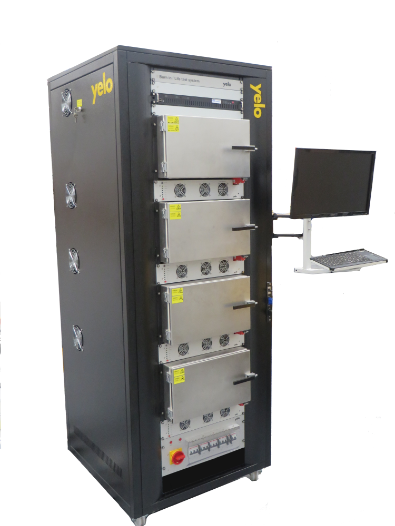
Burn-in tests are applied to laser diodes during manufacturing to identify potentially defective devices. This early detection process allows for a large decrease in so-called ‘infant mortality rates’ of laser diodes; the process effectively screens out lasers with short life expectancies.
Image left:
The Yelo Y4000 laser diode burn-in and life test system can accommodate up to 5,000 diodes and is designed to provide a high level of reliability to ensure only good lasers advance towards production of optoelectronic components and modules.
All laser diodes are subjected to burn-in testing during manufacturing. Screening out laser diodes with short life expectancies involves burn-in testing of the devices at high temperatures. Burn-in testing can greatly increase test cycle times and manufacturing costs if not done in a way that maximizes performance, reliability and cost-effectiveness. It is therefore common that laser diodes have burn-in tests that run for under 100 hours. A laser diode is screened out through burn-in tests if a change in one or more of the operating parameters is detected. These key operating parameters are measured both before and after high temperature burn-in tests. It is important during testing that the temperature and operating current are as high as possible to minimise test completion timelines. However, it is also important to avoid setting them so high that the laser degrades in a manner that would not occur during normal operating conditions.
The Yelo 42U rack based system provides a modular, temperature-controlled environment designed to accommodate low power devices requiring up to 250mA channel current, and can burn-in up to a temperature of 150°C. The system is built comprising 4 separate ovens, allowing burn-in to be performed across 4 different temperature zones simultaneously if required.
Other key benefits include:
Yelo’s VP Sales and Marketing Martin Collins said, “We understand that the needs of the market are evolving, optoelectronic devices are getting much smaller and volume demands are rising. We wanted to innovate and offer a new solution to our customers. The Y4000 system provides a much higher density than our existing systems. This enables our customers to perform burn-in and life test at much higher volumes with the possibility of taking up less floor space.”
The company says that the Y4000 is particularly useful for identifying devices that will fail very early in their use, as well as stabilising device operating parameters thus ensuring that every device shipped meets the appropriate quality standards.
For more information, visit www.yelo.co.uk or email marketing@yelo.co.uk
About Yelo:
Yelo is a manufacturer of automated test equipment for the photonics and electronics industries; the company is based in Northern Ireland. Founded in 1983, it has a team of 40 including: Electronic engineers, mechanical design engineers, software developers and test/commissioning/support engineers. Yelo currently has over 300 burn-in and life test systems installed internationally, with a major presence in the USA, Asia and Europe. In response to a growing demand for its products, the company opened a new £2 million facility in November 2017 in Carrickfergus, Northern Ireland.
PICs will play an increasingly important role as bandwidth demands are driving the move from 100G to 400G datacenter interconnects. Inphi’s CTO describes key factors driving this opportunity and the shape of things to come as photonic integration moves deeper into network systems.
By: Radha Nagarajan, CTO, Optical Interconnect, Inphi Corporation
Introduction
The growing bandwidth demands of cloud service providers (CSPs,) offering a variety of web-based, commercial and consumer services, have in turn driven the demand for higher and higher speed optical solutions to connect switches and routers at the different tiers of the CSP’s data center network. Today, this requires solutions at 100Gbit/s within and interconnecting datacenters. As the demand grows further, Moore’s law dictates that advances in switching silicon will enable switch and router platforms to maintain switch chip radix parity, while increasing capacity per port. As servers (lowest rungs of the datacenter) with 50Gbit/s ports are being considered for deployment, the next generation of switch chips are all targeting per-port capacities of 400Gbit/s. This in turn is driving the need for 400Gbit/s optical interconnects. Here, we focus on the application of Silicon photonics for the implementation of the current generation 100Gbit/s interconnects between datacenters and briefly discuss the path to 400Gbit/s.
How are Datacenters Connected?
The common notion of datacenters pictures them as large, fixed physical locations that are limited in land area. The reality is that interconnected, individual sites are geographically diverse and the optical interconnects between them could span anywhere from few kilometers of terrestrial distances to thousands of kilometers across subsea routes. Optical transmission distances of more than 2 kilometers are the inter-datacenter interconnects (DCI), external to the physical datacenter. Let us consider the three primary types of DCIs.
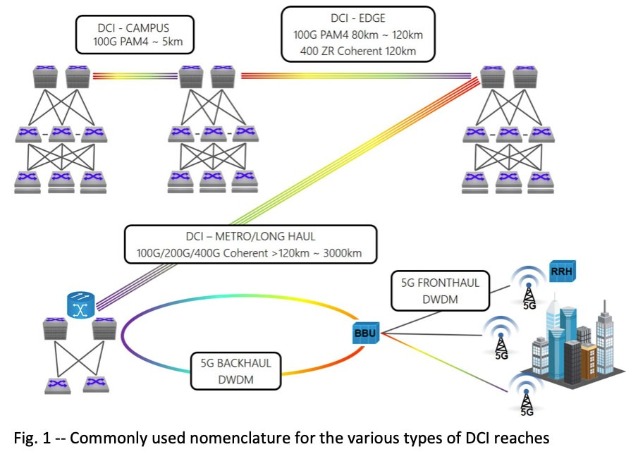
DCI-Campus
These connect datacenters which are close together, as in a campus environment. The distances are typically limited to 2km-5km. There is an overlap of CWDM and DWDM links over these distances, depending on fiber availability in the environment.
DCI-Edge
The reaches for this category range from 2km to 120km. These are generally latency limited and used to connect regional, distributed datacenters.
DCI-Metro/Long Haul
The DCI-Metro and DCI-Long Haul, as a group, lumps fiber distances beyond the DCI-Edge up to
3000km, for terrestrial links, and longer for subsea fiber. Coherent modulation format is used for
these, and the modulation type may be different for the different distances.
Direct detection and coherent are the choices of optical technology for the DCI (category 2). Both are
implemented using the DWDM transmission format in the C-band, 192 THz to 196 THz window, of the optical fiber. Direct detection modulation formats are amplitude modulated, have simpler detection schemes, consume lower power, cost less, and in most cases, need external dispersion compensation.
Coherent modulation formats are amplitude and phase modulated, need a local oscillator laser for detection, sophisticated digital signal processing, consume more power, have a longer reach and are more expensive.
For 100Gbit/s, a 4 level Pulse Amplitude Modulation (PAM4), direct detection format is a cost-effective
solution for DCI Edge applications. PAM4 modulation format has twice the capacity of the traditional NRZ format. For the next generation 400Gbit/s (per wavelength) DCI systems, 60GBaud, 16 QAM, coherent format is the leading contender.
Switch Pluggable 100Gbit/s PAM4 DWDM Module
The switch pluggable QSFP28 module (SFF-8665 MSA compatible) is based on a highly integrated, silicon
photonics optical chip and a PAM4 ASIC as shown in Figure 2. The four, KR4 encoded 25.78125Gbit/s inputs are first stripped of their host FEC (KR4). Then the two, 25Gbit/s streams are combined into a single PAM4 stream and a more powerful line FEC called IFEC is added, making the line rate 28.125GBaud per wavelength. The 4, 25Gbit/s Ethernet streams are thus converted to 2, 28.125GBaud PAM4 optical streams.
A highly integrated Si photonics chip is at the optical heart of the pluggable module. Compared to indium phosphide (InP), the silicon CMOS platform allows a foundry level access to the optical component technology at much larger 200mm and 300mm wafer sizes. The photodetectors for the 1300nm and 1550nm wavelength range are built by adding germanium (Ge) epitaxy to the standard silicon CMOS platform. Further, Silica and Silicon Nitride based components may be integrated to fabricate low index contrast and temperature insensitive optical components.
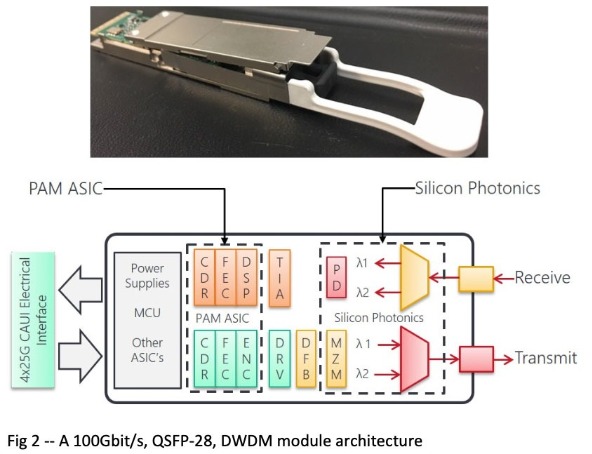
In Figure 2 the output optical path of the Si photonics chip contains a pair of traveling wave Mach Zehnder modulators (MZM), one for each wavelength. The two wavelength outputs are then combined on-chip using an integrated 2:1 interleaver which functions as the DWDM multiplexer. The same Si MZM may be used for both NRZ and PAM4 modulation formats, with different drive signals.
There are a pair of integrated high-speed Ge photodetectors (PD) in the receive path. The dual wavelength receive signal is separated using a de-interleaver structure which is similar to the one used in the transmitter. Since the polarization state of the incoming optical signal is not deterministic, the receive path is designed to be polarization diverse to eliminate polarization induced signal fading. This is accomplished by using a low loss polarization beam splitter (PBS), also integrated onto the silicon photonics chip. After the PBS, transverse electric (TE) and transverse magnetic (TM) paths are processed independently, and then combined again at the PDs. The DFB lasers are external, and edge coupled to the silicon photonics (SiP) chip. Both the MZM driver amplifier and the PD transimpedance amplifier are wire bonded to the SiP chip. We use a direct coupled MZM differential driver configuration to minimize electrical power consumption.
The PAM4 ASIC is the electrical heart of the module. The ASIC supports a dual wavelength 100Gbit/s mode (with 4 x 25Gbit/s inputs), and a single wavelength 40Gbit/s mode (with 4 x 10Gbit/s inputs). The ASIC has MDIO and I2C management interfaces for diagnostics and device configuration.
For a simple point to point transmission system, with two EDFA’s, the ultimate transmission distance is limited by the launch power at the transmitter. We have demonstrated a PAM4 link in standard SMF (single mode fiber) up to 120km for a total fiber loss of 26.2dB.
The DCI-Campus and Edge link configurations are shown in Figure 3. A DCI-Edge configuration has two EDFA’s and a DCM (dispersion compensation module,) which may be part of the mid-stage of the transmit or the receiver EDFA. A DCI-Campus configuration can operate off a single receive EDFA without any external dispersion compensation, since the intrinsic dispersion tolerance of ±100ps/nm is sufficient for this distance. The inset to the bottom, shows the optical spectrum for a fully loaded 40 channel system for a maximum of 4Tbit/s capacity in a fiber pair. The rack to the left, shows an Arista 7504 chassis switch with 36 QSFP28 ports, fully loaded. A single blade of the switch can support 3.6Tbit/s of traffic in any one direction.
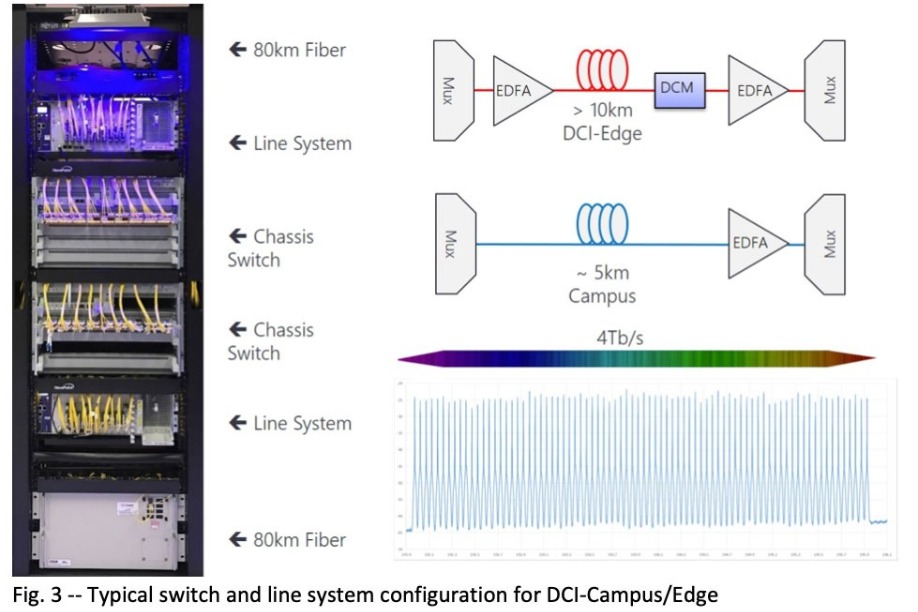
Evolution to Switch Pluggable 400Gbit/s DWDM Module
As bandwidth demands in data center networks continue to grow, Moore’s law dictates that advances in
switching silicon will enable switch and router platforms to maintain switch chip radix parity while increasing capacities per port. At the time of this manuscript’s writing, the next generation of switch chips are all targeting per-port capacities of 400G. Accordingly, work has begun to ensure the optical ecosystem timelines coincide with the availability of next-gen switches and routers. Toward this end, a project has been initiated in the Optical Internetworking Forum (OIF), currently termed 400ZR, to standardize next-gen optical DCI solutions and create a vendor-diverse optical ecosystem. The concept is in principle like that of the DWDM PAM4 technology described here, but scaled up to support
400Gbit/s requirements.
About the author:
Dr. Radha Nagarajan has served as Inphi’s Chief Technology Officer, Optical Interconnect, since June 2013. He brings more than 20 years of experience in the area of high-speed optical interconnects. Prior to joining Inphi, he was with Infinera, as a Fellow, working on the design, development and commercialization of large-scale photonic integrated circuits.
Dr. Nagarajan is a Fellow of the Institute of Electrical and Electronics Engineers (IEEE), the Optical Society of America (OSA) and the Institution of Engineering and Technology (IET, UK). He has authored four book chapters in the areas of high-speed optical components and photonic integration. In 2006, he shared the IEEE/LEOS Aron Kressel Award for his work on commercializing large-scale photonic integrated circuits. He has been awarded more than 161 US patents and authored/coauthored over 180 papers in technical journals and conferences in the field of optical components and systems. Dr. Nagarajan grew up in Singapore where he received his B.Eng. degree in Electrical Engineering from the National University of Singapore. He obtained his M.Eng. degree in Electronic Engineering from the University of Tokyo, and Ph.D. in Electrical and Computer Engineering from the University of California, Santa Barbara.
Synopsys is defining a new era of photonic circuit design with unified flow and custom process design kit (PDK) support. Company experts and invited speakers will present a free, immersive and hands-on workshop the week before the PIC International Conference to teach designers how to navigate this new era of photonic circuit design. PIC Magazine invited Niek Nijenhuis, Global Business Development Manager of Photonic Solutions at Synopsys, to discuss how the workshop will benefit photonic circuit designers.
One of the challenges faced by photonic foundries and PIC designers is the disconnect between the pace of technological advances in the industry and the readiness of photonic design automation (PDA) infrastructure. Synopsys is driving the advancement of PIC technologies with its PIC Design Suite, which comprises the OptSim Circuit and OptoDesigner tools and supports a wide range of application requirements, from data communications to sensors and biomedical devices. The suite offers a seamless PIC design flow from system-level design and verification through PIC design capture, layout, verification and manufacturing, as well as access to a single, world-class support channel.
Synopsys’ PIC PDA suite also works seamlessly with OptSim, the company’s industry-leading telecommunications and data communications photonic network modeling tool. OptSim comes with a rich library of photonic and electronic components, stimulus generators, and analysis routines, which can be used to model any photonic communications network. It shares a graphical interface with OptSim Circuit that allows the custom PIC to be simulated in context with the rest of the full photonic network.
Synopsys has lowered access barriers to PIC technology with support for more than 30 PDKs available from foundries around the world for photonic processes including silicon, silicon nitride, indium phosphide, polymers, and silica on glass. PDKs provide a crucial link between photonic circuit simulation and layout tools by supporting efficient, high-level design capture and concept verification, semi-automated layout with automated manufacturing sign-off checks, and foundry-specific GDS synthesis for mask generation. Over the last three years, OptoDesigner has enabled more than 500 commercial and research design tape-outs.
Synopsys also provides a full suite of device-level simulation, layout, and modeling capabilities that enables designers to create their own PDK building blocks using foundry-specific process data. The feature, known as Custom PDK, enables designers to create their own value-added IP that can be combined on-chip with foundry-supplied PDK building blocks. Device-level simulators include algorithms such as BPM, EME, CPL, FDTD, and specialized algorithms for grating and laser design.
Synopsys experts will lead a free, four-day workshop exploring the latest electro-photonic design automation (EPDA) tools adjacent to the PIC International Conference; the workshop is 19-22 March, 2019 at the Sheraton Airport Hotel, Brussels; the PIC International conference is 26-27 March in the same location. Workshop attendees will learn how to use the latest software automation and optimization techniques for photonic circuit design, simulation and fabrication. For information about the workshop or to register, please visit the https://synopsys.picinternational.net/ .
Workshop topics will include an overview of the integrated photonics ecosystem, live demonstrations, and immersive, hands-on sessions using Synopsys’ PIC Design Suite for PDK-driven design. At the completion of the workshop, attendees will have an understanding of:
In addition, talks by foundry representatives will provide information about their specific PDK offerings and capabilities, and will give designers guidance for obtaining PDKs and participating in multi-project-wafer (MPW) runs to verify their ideas through manufacturing.
Synopsys has announced enhancements to its OptoDesigner suite; OptoDesigner 2018.12 is now available; key features in this release include:
For more details about these and other updates, please refer to the release notes included with the release software on the OSG Customer Support Portal. Visit https://www.synopsys.com/photonic-solutions.html to learn more about Synopsys’ photonic solutions.
Fraunhofer HHI has advanced its hybrid PolyBoard platform for PIC designs through its micro-optical bench concept. PolyBoard enables the first steps towards 3D photonic integration with ultra-widely tunable lasers for emerging applications such as life sciences, LIDAR, and quantum technologies.
By Martin Schell, Director, Fraunhofer Heinrich Hertz Institute
HHI’s hybrid photonic technology PolyBoard allows for a broad spectrum of applications, ranging from the traditionally photonic telecom/datacom fields, to life sciences and the emerging quantum technologies. The PolyBoard PICs rely on a polymer-based waveguiding platform, and in the past years, numerous optical building blocks such as 90° hybrids, AWGs, thin-film-based wavelength filters and polarization handling elements, variable optical attenuators, and optical switches have been made available [1],[2].
Actives such as laser diodes, gain chips and photo diodes can be integrated into the PolyBoards by means of end-fire coupling or micro-machined 45° mirrors. Additionally, on-chip coupling features, U-grooves, enable adjustment-free attachment of fibers, simplifying enormously the effort and lastly cost of photonic packaging. Most recently, three new developments in the PolyBoard technology have enabled new ways of approaching photonic integration to fulfill the demands of ever increasing complexity of PICs: an on-chip micro-optical bench, ultra-widely tunable lasers, and the capability for 3D photonic integration. In this article, these three new developments are reviewed, and a vision on their impact in different application fields is provided.

Figure 1 (left) Integrated optical isolator consisting of a polarization beam splitter (PBS), a Faraday rotator and half wave plate integrated via two GRIN-lenses. (right) Measurement results showing an optical isolation larger than 20 dB across the C-band.
PolyBoard micro-optical bench
One of the most challenging components to implement into today’s PICs are optical isolators and circulators. All published attempts for optical isolation are still far from reaching a performance attractive enough for their integration in PICs. On the other hand, micro-optical free-space based optical isolators, extensively used in packaged photonics, show low insertion and return losses as well as high optical isolation.
At ECOC 2018, HHI demonstrated a first PolyBoard integrated optical isolator consisting of an on-chip free-space section with GRIN-lenses for beam collimation [3]. The GRIN-lenses are inserted into pre-etched U-grooves, normally used for single mode fiber coupling, which enable passive alignment of the lenses and the polymer waveguides. This free-space section allows for the insertion of optical bulk materials such as Faraday rotators, which are one of the key components for the fabrication of optical isolators, or even complete miniaturized optical free-space isolators consisting of a 45° Faraday rotator and two polarization filters.

Figure 2. Concept of a PolyBoard integrated polarization independent circulator (left). Concept of an entangled photon source for quantum applications using a Potassium Titanyl Phosphate (KTP) crystal (right).
On-chip losses below 0.5 dB for chip integrated free-space sections have already been demonstrated, paving the way to PolyBoard based optical isolators with losses below 1.0 dB [4]. The integration of external Faraday rotators into the PolyBoard also enables the realization of optical circulators, targeting applications not only in telecommunications but also in life sciences, such as fiber based interferometer structures in optical coherence tomography (OCT). The concept for a PolyBoard enabled optical circulator is shown in Figure 2 (left).
Beyond the implementation of isolators and circulators, it is possible to use the Micro-Optical bench to integrate crystals such as Potassium Titanyl Phosphate (KTP) or Lithium Niobate (LiNbO3). This will allow the novel inclusion of nonlinear optical effects like spontaneous parametric down-conversion (SPDC) on PICs. These nonlinear crystals are envisioned to be key elements in the generation of entangled photon sources required for quantum communication (see Figure 2, right). This approach is currently being developed in the European flagship project UNIQORN, which started in October 2018. Together with 16 other consortium partners HHI takes a leading role in the development of PICs for applications in quantum technology like quantum key distribution (QKD) or quantum random number generators (QRNG). The PolyBoard Micro-Optical Bench allows for the integration of virtually every thinkable material and thus represents one of the unique features of the PolyBoard integration platform.
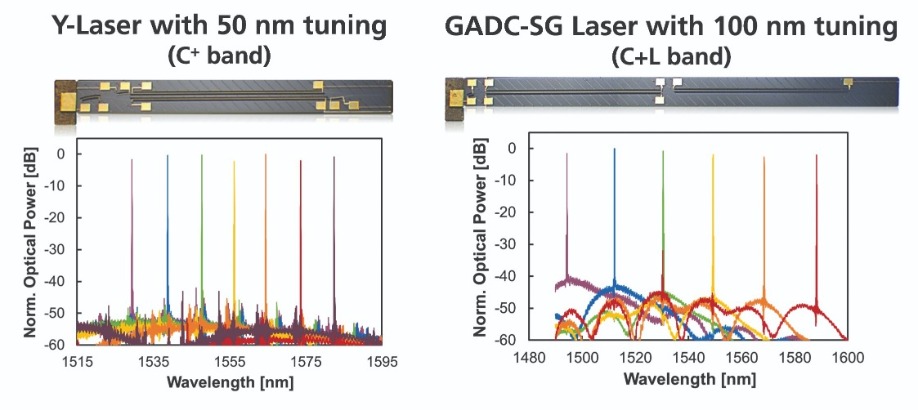
Figure 3. New PolyBoard-based ultra-widely tunable lasers. A first implementation (left), namely Y-laser, is based on the Vernier-effect to enhance the tuning range. Two sampled-gratings (SGs) act as comb reflectors with different periodicities. A tuning range of 50 nm along the C-band has been recently demonstrated. A second implementation, based on a SG periodic comb reflector and a grating-assisted directional coupler (GADC) as an intra cavity filter, has demonstrated tuning ranges of up to 100 nm. These two tunable lasers open the door towards ultra-broadband PolyBoard-based DWDM PICs in telecom/datacom applications.
Polymer materials can be used for the implementation of highly efficient thermo-optically tunable structures.
This allows for the development of III-V/polymer tunable DBR lasers with 20 nm tuning range along the C-band and, depending on the application, direct modulation capabilities of 10 Gb/s, output powers up to 40 mW, or linewidths narrower than 200 kHz.
Due to the thermal tuning, however, tuning ranges above 20 nm are not possible by simply heating a polymer Bragg grating. During the ECOC 2018 in Rome, this limit was overcome with two new III-V/polymer implementations, (see Figure 3) [5]. A first implementation, namely Y-laser, is based on the Vernier-effect to enhance the tuning range. Two sampled-gratings (SGs) act as comb reflectors with different periodicities. This increases the tuning range to 50 nm. Furthermore, a second implementation, based on a SG periodic comb reflector and a grating-assisted directional coupler (GADC) as a ultra-widely tunable intra cavity filter (GADC-SG) - has demonstrated tuning ranges of up to 100 nm. These new tunable laser devices open the door towards PolyBoard-based ultra-broadband DWDM PICs in telecom/datacom applications. A taste of the level of optical functionality that can be potentially implemented using the PolyBoard technology with these new laser types is shown in Figure 4, where a hybrid PIC comprising a tunable laser combined with Micro-Optical bench functionalities such as an optical isolator and an etalon-based wavelength monitor are presented.
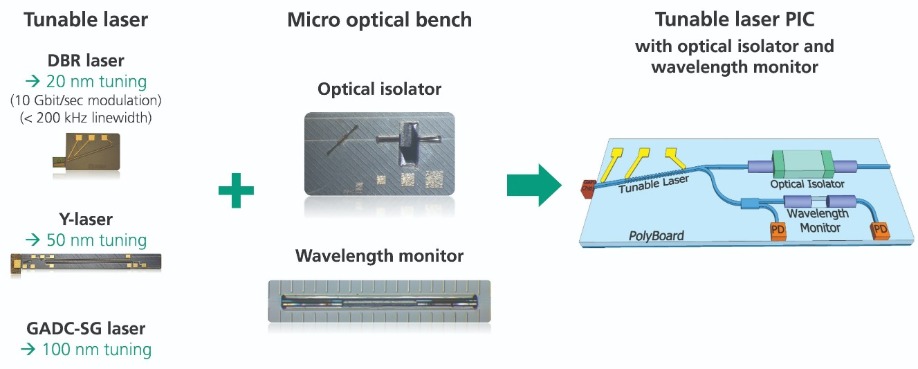
Figure 4. Concept of a PolyBoard PIC comprising already demonstrated optical building blocks such as tunable lasers, optical isolators, and wavelength monitors. This example shows the level of functionality that the PolyBoard technology can provide to PIC integration.
PolyBoard 3D photonic integration
The 3D photonic integration opens a new disruptive way for designing photonic integrated circuits. The possibility of a multilayer waveguide system to enable 3D photonic integration adds a new degree of freedom to PICs [1]. This newfound flexibility leads to novel applications like space division multiplexing (SDM), optical phased arrays for LIDAR, or large-scale crossing-free switching matrices. The latter has been demonstrated in 2D PICs [6], but due to the planar matrix design in large-scale switching matrices a large number of waveguide crossings occur, adding additional losses and channel crosstalk to the system (Figure 5, left). By entering the third dimension, most of these waveguide crossings can be avoided, leading to reduced on-chip losses and crosstalk (Figure 5, right).

Figure 5. Schematics of a 64x64 switching matrix in a) two-dimensional structure [7] and b) three-dimensional structure.
The right side of Figure 6 shows that losses as low as 1.0 dB for the TE and 0.9 dB for the TM polarization at a wavelength of 1557 nm can be achieved.
Within the EU-H2020 Project 3PEAT, complex hybrid 3D PICs for LIDAR and miniaturized vibrometers are being developed combining the 3D photonic integration features of HHI’s PolyBoard and optical beam forming networks in LioniX’s TriPleX technology (Figure 7, left). Furthermore, 3D photonic integration is also being used in a 3D crossing-free switching matrix for top of rack switches in data centers (Figure 7, right).

Figure 6. 3D sketch of a vertical MMI coupler for a vertical centre-to-centre distance of 7.2 µm with simulated results for the optical light field (left). Results from the fiber-chip-fiber measurement of a fabricated VMC for TE and TM polarization. The fabricated device has a length of 173 µm and a width of 1.4 µm. The marked line corresponds to the simulated minimum loss for a VMC width of 1.4 µm and a wavelength of 1550 nm (right).
The PolyBoard Micro Optical bench, the PolyBoard Ultra-Widely Tunable lasers, and the first steps into the third dimension, together with the transparency of polymers from the NIR down to the visible (VIS) range, allows for the implementation of completely new classes of PICs over a broad spectrum of wavelengths.
These developments position the PolyBoard platform as an enabling photonic integration technology in emerging application fields such as life sciences, LIDAR, and quantum technologies.

Figure 7. Schematic layout of a PolyBoard/TriPleX based laser Doppler Vibrometer module (left), schematic 4 x 4 switching module consisting of four PolyBoard waveguiding layers (right)
References
[1] D. de Felipe et al., “Recent Developments in Polymer-Based Photonic Components for Disruptive Capacity
Upgrade in Data Centers”, J. of Lightwave Technology, Vol. 35, No. 4, p. 683 (2017).
[2] M. Kleinert et al., “Photonic integrated devices and functions on hybrid polymer platform”, Photonics West,
10098-45, 2018.
[3] H. Conradi et al., “High Isolation Optical Isolator: A new Building Block for PolyBoard Photonic Integrated
Circuits”, We4C.3, ECOC (2018).
[4] M. Happach et al., “On-chip free beam optics on a polymer-based photonic integration platform”,
Vol. 25 No. 22, Optics Express (2017).
[5] D. de Felipe et al., “Ultra-Wide Band Tunable Lasers on the PolyBoard Polymer-Waveguide Based Photonic
Integration Platform”, We4C.3, ECOC (2018)
[6] L. Schares et al., “Etched-facet semiconductor optical amplifiers for gain-integrated photonic switch
fabrics”, ECOC 2015, Valencia.
[7] M. Nuck et al., “Low-loss Vertical MMI Coupler for 3D Photonic Integration”, Tu4C.6, ECOC (2018).
Silicon photonics technology has definitely reached a first level of maturity, as it can be found nowadays in commercial products for intra- and inter-datacenters communications at high data rates. Higher volume markets such as intra-rack communications could be addressed by solving three main challenges: the packaging, the energy consumption, and the laser integration.
By Karim HASSAN, PhD, Researcher and Project Manager at CEA-Leti
The convergence of photonic technologies into a CMOS compatible silicon photonic platform remains a key challenge while several fabrication supply chains and industrial products are available in the field of high speed communications on optical fiber. Nowadays, the circuit design tools are available on several software platforms. However, silicon photonics is still suffering from the lack of integrated light sources. Existing packaging solutions offer a straightforward way to combine III-V laser sources and silicon photonics integrated circuits in order to address the market today, at the expense of a high cost and low volume production. On the other hand, the hybridization of III-V gain material (which remains the materials of choice to achieve semiconductor laser sources) can be realized using III-V direct bonding on top of patterned silicon. Subsequent laser demonstrations relying on CMOS-compatible process for the silicon part have been in most cases followed by process steps carried out with small wafer III-V fabrication lines (typically below 4-inch wafers). With such integrations, the cost advantage of silicon photonics based on the use of CMOS platforms and large wafer format is not valid.
The issues regarding the integration of III-V material go beyond the introduction of the material itself on CMOS lines. In fact, fundamental aspects such as having a low access resistance with CMOS back-end of line (BEOL) metals onto III-V compounds is not straightforward since noble metals, e.g. gold, cannot be used. The thin SOI (<310nm) used for getting single mode silicon photonic integrated circuits (PICs) makes optical coupling with the thick III-V gain material (>2µm) difficult. It is worth noting that the topology of III-V components, having a large height of about 3µm, makes the co-integration within the BEOL of active silicon devices interconnects incompatible.
Furthermore, while large format of III-V wafer epitaxy is still in progress, most of the III-V suppliers can provide laser stack onto wafers smaller than 4 inch, which makes the use of dies rather than wafer mandatory for the hybridization on 200mm silicon wafer (as well as 300mm).
Nevertheless, the use of III-V dies generates additional difficulties for III-V processing due to undesired lateral etching of the dies during the III-V substrate removal. An overall integration strategy must be developed in order to solve these technological barriers.
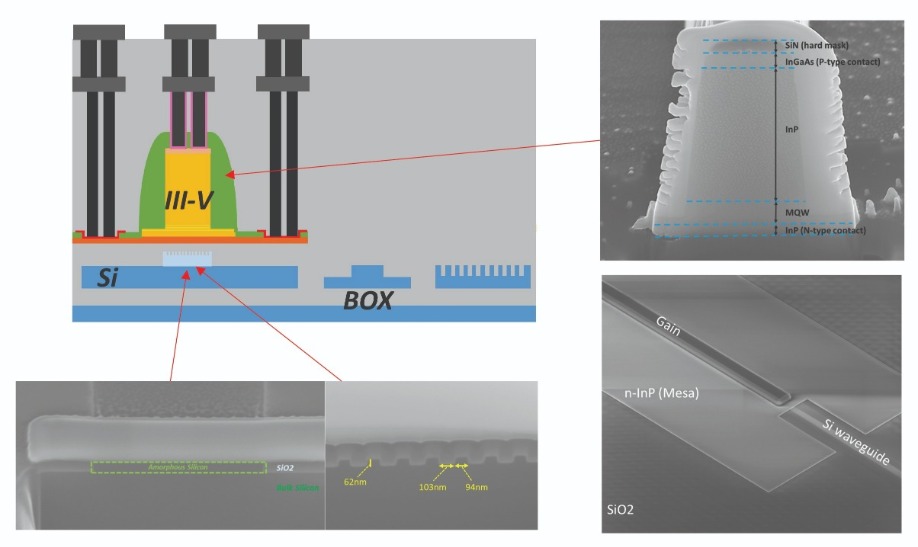
Figure 1. Schematic view and scanning electron microscopy images of III-V on silicon laser fabricated on 200mm CMOS lines.
In order to break the existing technological limitations for mass production of hybrid PICs, CEA-Leti’s R&D fabrication platform has developed a first laser integration on a 200mm fully CMOS-compatible silicon photonics platform, as depicted in the Figure 1.
The fabrication process can be divided into three main parts, with first the silicon patterning followed by the III-V hybridization through molecular bonding, prior to the III-V patterning (including the CMOS metallizations). The optical coupling between III-V and silicon requires thick silicon waveguides, which is obtained by a localized thickening with amorphous silicon, as shown in Figure 1. Next, a chemical and mechanical planarization (CMP) is used to provide a smooth oxide layer for the direct bonding of III-V on silicon. The novel patterning of the III-V material that has been developed relies entirely on the 200mm platform. The new process flow proposed by CEA-Leti uses selective reactive ion etching (RIE) steps on both p-InP and p-InGaAsP.
New BEOL for lasers
Such a new patterning sequence allows us to encapsulate the III-V completely prior to the BEOL, which will remain planar, similar to standard silicon photonics components. Consequently, a high density of vias can be patterned on the SiO2 encapsulation and subsequently filled with tungsten on top of both contact sides made of Ti metallization deposited by magnetron sputtering (PVD), prior to the final AlCu micron-thick pad layer, as depicted in Figure 2.
This new CMOS BEOL for lasers, developed within the framework of the IRT Nanoelec Photonic Program, a French consortium involving CEA-Leti, ST Microelectronics, ALMAE, CNRS-LTM, and Mentor Graphics, results in a state-of-the-art serial resistance on hybrid lasers ranging from 3 Ohms to 4 Ohms.
Large scale automated testing
Large scale automated testing is also of great interest when arguing about large volume production of hybrid PICs. Thanks to the novel 200mm process, full wafers can be thoroughly mapped with electro-optical fiber-to-fiber measurements. Such a test is made possible by the use of fiber grating couplers fabricated onto the silicon, similarly to standard silicon PICs. Most of the developments required specifically for the tests of hybrid lasers relies on the spectral (CW and pulsed) and thermal characteristics. Even though silicon devices are also sensitive to temperature variations, the behavior of hybrid lasers regarding thermal fluctuation and the aging of such object is vital to ensure the operability on datacenter environments.
There are still some challenges in this regard to provide high temperature tests before the packaging, with, for instance, the improvement of optical fiber position and vibrations due to convection over the wafer and dilation of it. The development of on-wafer laser testing is not only relevant for the monitoring of the fabrication yield, but also for sorting out the hybrid photonics chips as a function of their performances before packaging.
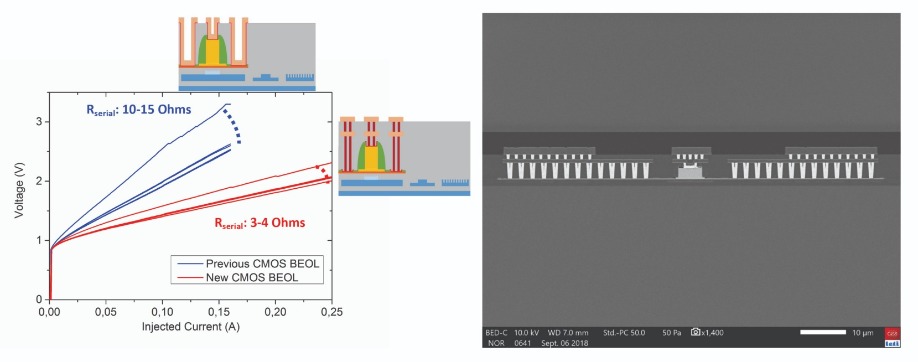
Figure 2. Experimental IV curves on 200mm CMOS hybrid lasers with 1 and 2 levels of BEOL and scanning electron microscope view of the cross-section of such laser developed on CEA-Leti’s R&D fabrication platform.
Beyond the performances and efficiency, the cost of hybrid III-V/Si transceivers is of great interest. While mass production of silicon chips is cheap, the addition of III-V materials can increase significantly the budget per PIC. One can note that the consumption of III-V material must be minimized in order to reduce the environmental impact (by the material itself or the chemicals used for waste treatment). Figure 3 shows 3 mm x 3 mm III-V dies on top of a 200mm SOI wafer (including silicon photonics circuits for high lasers) after the molecular bonding. The newly developed 200mm die bonding reached a yield ranging from 70 to 99%, with 90% of the successfully die transferred having 99% of III-V material bonded onto the SOI surface. While the molecular bonding itself can be executed the same way as wafer bonding, the substrate removal is more critical for dies due to undesired lateral etching.
The thinning was ensured by first an original sequence of grinding operation down to 50µm III-V remaining prior to a chemical wet etching used to remove the remaining part of the substrate. By adding a grinding step before the wet etching, the lateral consumption of III-V during the substrate removal was reduced by a factor between 3 and 5. The III-V patterning on those dies is now in progress to realize hybrid lasers.
Conclusions
Recent developments led by CEA-Leti within IRT Nanoelec have led to a full CMOS friendly laser integration process, exhibiting very low serial resistance thanks to novel contacts metallurgy. In addition, wafer scale approaches allows high yield bonding of reduced area III-V coupons/dies onto SOI wafers, drastically reducing the cost of next generation photonic transmitters. The scalability towards 300mm for both CMOS contacts and die bonding is currently under development, paving the way for the adoption of silicon photonic technology in a variety of emerging applications such as system in a package photonic transceivers, high performance computing and PIC based LiDARs.
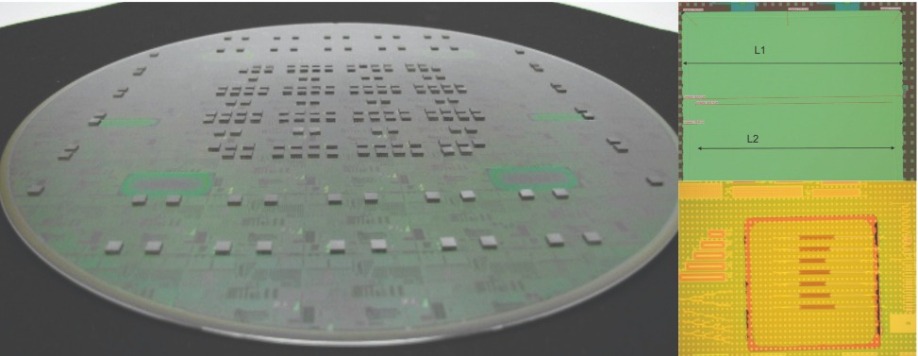
Figure 3. III-V dies on 200mm silicon wafer, and microscope images of such die after the III-V substrate removal and during the 200mm CMOS process of hybrid lasers.
References
CEA Tech is the technology research branch of the French Alternative Energies and Atomic Energy Commission (CEA), a key player in innovative R&D, defence & security, nuclear energy, technological research for industry and fundamental science.
CEA was named by Thomson Reuters as the second most innovative research organization in the world in 2017. CEA Tech leverages a unique innovation-driven culture and unrivalled expertise to develop and disseminate new technologies for industry, helping to create high-end products and provide a competitive edge.
Follow us on www.leti-cea.com and @CEA_Leti

UCSB engineering professor John Bowers’ group develops a high-performance quantum dot mode-locked laser on silicon
John Bowers, left, and Songtao Liu
Ten years into the future. That’s about how far UC Santa Barbara electrical and computer engineering professor John Bowers and his research team are reaching with the recent development of their mode-locked quantum dot lasers on silicon. It’s technology that not only can massively increase the data transmission capacity of data centres, telecommunications companies and network hardware products to come, but do so with high stability, low noise and the energy efficiency of silicon photonics.
“The level of data traffic in the world is going up very, very fast,” said Bowers, co-author of a paper on the new technology in the journal Optica. Generally speaking, he explained, the transmission and data capacity of state-of-the-art telecommunications infrastructure must double roughly every two years to sustain high levels of performance. That means that even now, technology companies such as Intel and Cisco have to set their sights on the hardware of 2024 and beyond to stay competitive.

Photo Credit: Brian Long illustration
Enter the Bowers Group’s high-channel-count, 20 gigahertz, passively mode-locked quantum dot laser, directly grown — for the first time, to the group’s knowledge — on a silicon substrate. With a proven 4.1 terabit-per-second transmission capacity, it leaps an estimated full decade ahead from today’s best commercial standard for data transmission, which is currently reaching for 400 gigabits per second on Ethernet.
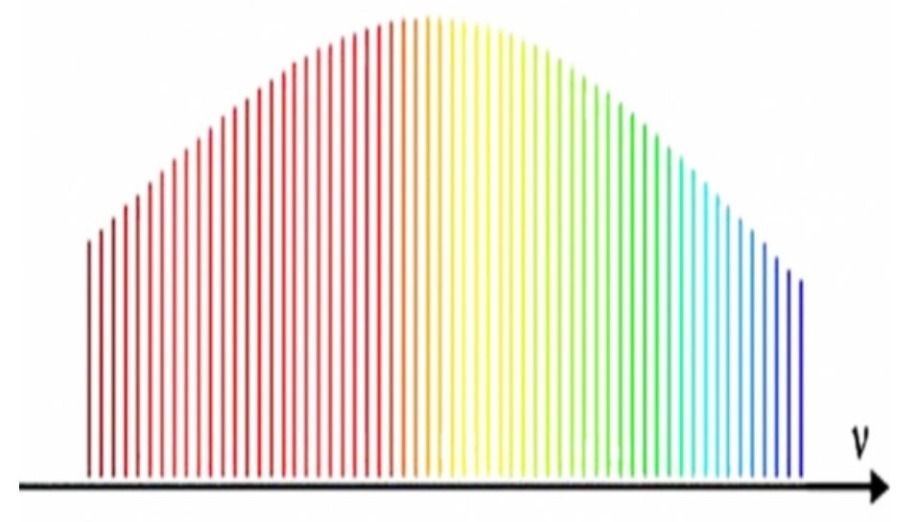
Photo Credit: Image courtesy Songtao Liu
The technology is the latest high-performance candidate in an established technique called wavelength-division-multiplexing (WDM), which transmits numerous parallel signals over a single optical fiber using different wavelengths (colors). It has made possible the streaming and rapid data transfer we have come to rely on for our communications, entertainment and commerce.
The Bowers Group’s new technology takes advantage of several advances in telecommunications, photonics and materials with its quantum dot laser — a tiny, micron-sized light source — that can emit a broad range of light wavelengths over which data can be transmitted.
“We want more coherent wavelengths generated in one cheap light source,” said Songtao Liu, a postdoctoral researcher in the Bowers Group and lead author of the paper. “Quantum dots can offer you wide gain spectrum, and that’s why we can achieve a lot of channels.” Their quantum dot laser produces 64 channels, spaced at 20 GHz, and can be utilized as a transmitter to boost the system capacity.
The laser is passively ‘mode-locked’ — a technique that generates coherent optical ‘combs’ with fixed-channel spacing — to prevent noise from wavelength competition in the laser cavity and stabilize data transmission.
This technology represents a significant advance in the field of silicon electronic and photonic integrated circuits, in which the primary goal is to create components that use light (photons) and waveguides — unparalleled for data capacity and transmission speed as well as energy efficiency — alongside and even instead of electrons and wires. Silicon is a good material for the quality of light it can guide and preserve, and for the ease and low cost of its large-scale manufacture. However, it’s not so good for generating light.
“If you want to generate light efficiently, you want a direct band-gap semiconductor,” said Liu, referring to the ideal electronic structural property for light-emitting solids. “Silicon is an indirect band-gap semiconductor.” The Bowers Group’s quantum dot laser, grown on silicon molecule-by-molecule at UC Santa Barbara’s nanofabrication facilities, is a structure that takes advantage of the electronic properties of several semiconductor materials for performance and function (including their direct band-gaps), in addition to silicon’s own well-known optical and manufacturing benefits.
This quantum dot laser, and components like it, are expected to become the norm in telecommunications and data processing, as technology companies seek ways to improve their data capacity and transmission speeds.
“Data centres are now buying large amounts of silicon photonic transceivers,” Bowers pointed out. “And it went from nothing two years ago.”
Since Bowers a decade ago demonstrated the world’s first hybrid silicon laser (an effort in conjunction with Intel), the silicon photonics world has continued to create higher efficiency, higher performance technology while maintaining as small a footprint as possible, with an eye on mass production. The quantum dot laser on silicon, Bowers and Liu say, is state-of-the-art technology that delivers the superior performance that will be sought for future devices.
“We’re shooting far out there,” said Bowers, who holds the Fred Kavli Chair in Nanotechnology, “which is what university research should be doing.”
Research on this project was also conducted by Xinru Wu, Daehwan Jung, Justin Norman, MJ Kennedy, Hon K. Tsang and Arthur C. Gossard at UC Santa Barbara.
Nanoscribe (Germany) has enhanced its lineup of micrometer precision 3D printers with the introduction of its new Photonic Professional GT2 microfabrication system. The high-resolution 3D printers add additional capabilities including expanded printing range up to the millimeter scale as well as industry-oriented features for ‘maskless’ lithography.
According to Nanoscribe CEO Martin Hermatschweiler, hardware optimizations and software components as well as the company’s IP-Q printing materials developed for high volume applications were key to enabling the company’s latest 3D printer release.
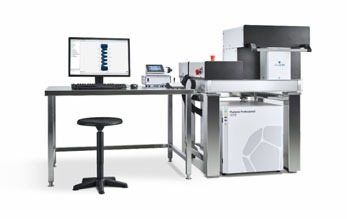
Figure 1: The Nanoscribe Photonic Professional GT2 system is shown above. The company’s new 3D printer enables the production of larger structures with high precision more quickly than competing solutions.
“High resolution microstructures up to a height of 8mm can now be produced for the first time. While Nanoscribe devices have always been optimally suited to the additive production of the most detailed structures, objects with sub-micrometer details from (typically) 160 nanometers up to the millimeter range on a printing area of up to 100x100 mm² can now be produced in a very short time,” he remarked.

Figure 2: Nanoscribe’s new GT2 can print filigree structures up to the millimeter range with extremely high resolution.
Depending on the desired size and resolution, users can choose from sets of objectives, substrates, materials, and automated processes tailored to their applications. The user-friendly 3D printing workflow enables the fabrication of individual elements with maximum shape accuracy and surface smoothness, meeting the requirements for microlenses in the smartphone industry or filigree scaffold structures utilized in cellular biology. Likewise, high-precision masters can be produced for molding processes in series production on a scale and with a degree of design freedom that cannot be achieved with alternative subtractive nor additive manufacturing technologies.
“The extension of the maximum print volumes toward the macroscale was a ‘great wish’ of our customers and project partners from industry,” said Hermatschweiler. “With this update of our extremely successful generation of Photonic Professional devices, we have now succeeded in overcoming previous physical limitations while increasing the performance of the devices by a factor of up to 10 in terms of productivity and speed,” he added.
“At Nanoscribe, we believe that our technology is perfectly suited to address the challenges faced by photonic designers and others working at nano-scale thanks to the tremendous flexibility of additive micro-printing. Our technology allows placing micro-structures with very high accuracy - some of our costumers routinely place optical elements with sub-100 nm accuracy. Combined with very small sub-micron feature sizes and surface roughness better than 10 nm, such precision naturally enables completely new solutions in photonic packaging,” he explained.
“Our driving goal is providing the best tools on the market to our customers from academia and industry which we believe will enable them to successfully develop 3D printed nano- and microstructures. We provide comprehensive support ranging from material development over fabrication support to design advice. In fact, several of our employees come from an integrated photonics, packaging and micro-optics background,” he added.
Extended Range of Industry Applications
Hermatschweiler said that Nanoscribe’s new Photonic Professional GT2 3D printer can significantly shorten product development cycles, especially in cases where large-volume structures in the millimeter range are required, such as for microfluidic elements (filters or nozzles), lab-on-a-chip applications, or micro rapid prototyping. In the field of sensor and actuator technology, various product components can now be printed quickly and precisely on MEMS components or silicon chips without further adjustment or assembly processes thanks to the variety of printable substrates. Photonic Professional GT2 systems will also open up new possibilities in the field of medical technology, such as the direct printing of micro-optics on glass fibers for minimally invasive endoscopes or for the manufacture of microneedles for painless drug delivery through the skin.
Functional Principle of Two-Photon Polymerization in 3D Printing
Nanoscribe systems combine the technology of two-photon polymerization with the workflow of a conventional 3D printing process. Their system utilizes a precisely focused femtosecond laser to cure a photosensitive material layer-by-layer. In a simple workflow, software especially developed for the printing process supports the import of CAD models with extensive configuration options, including a wide selection of preset parameters. A 3D preview as well as a real-time camera monitoring supports users seeking optimal adjustment and monitoring of the 3D printing process.
Nanoscribe’s proprietary software programs (DeScribe and NanoWrite) have been enhanced for the company’s latest Photonic Professional GT2 printer generation. Up to 10-times higher printing speeds can be achieved with the system’s intelligent printing strategies. Thanks to enormous design freedom, Nanoscribe printers can produce structures of varying complexity: for example, grating-like high resolution photonic structures in 2D, hemispherical microlenses with vertical slopes in 2.5D, and complex 3D objects such as gas-dynamic micronozzles can all be printed through nano-scale additive manufacturing. Parts printed with replicable topographies can also serve as polymer masters for molding processes. Using galvanic processes, 3D printed polymer masters can be metallized in order to be used as nickel shims for mass production utilizing industry-standard injection molding processes.
According to Nanoscribe, the company’s two-photon polymerization is best qualified amongst competing solutions for creating the most detailed, finely-crafted structures on the micro- and mesoscale. While other 3D printing technologies, such as Polyjet, DLP (Digital Light Processing), or SLA (stereolithography), excel from the centimeter range, the strengths of Photonic Professional GT2 systems lie in its ability to create device structures utilizing ultra-precise 3D microfabrication.
A complete System
Nanoscribe also announced its new IP-Q Photoresin to complement the introduction of its Photonic Professional GT2 print system. In the Nanoscribe IP Photoresin portfolio there are suitable options for varying requirements, such as submicron features, overhanging elements, optical-quality surfaces or high-speed microfabrication up to the macroscale. The Photonic Professional GT2 printers work as open systems for a broad range of materials. The IP resins are exclusively designed and optimized for two-photon polymerization (2PP) and their use with Nanoscribe’s 3D printers.
Nanoscribe has already partnered with a multitude of manufacturers, research institutes and universities that are seeking new approaches to creating advanced photonic and semiconductor device structures utilizing additive manufacturing.
For example, the Dutch research institute AMOLF has developed and fabricated a 3D nanophotonic lens in collaboration with the Western University in Canada and the City University of New York (USA.) Using a Photonic Professional System from Nanoscribe, the researchers printed an extremely small lens on top of a gallium arsenide nanowire, which is only 80 nm thick and acts as a light emitter. This way, the combination of a nanolens and a nanowire enables focused light emission, compared to an almost uniform emission of the nanowire itself.
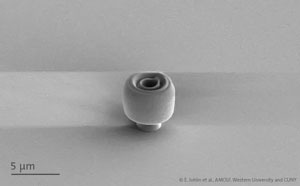
Figure 3: Dutch researchers at AMOLF have developed and fabricated a 3D nanophotonic lens in collaboration with researchers in Canada and the US using a Nanoscribe Photonic Professional System. The researchers printed an extremely small lens on top of a gallium arsenide (GaAs) nanowire, which is only 80 nm thick and acts as a light emitter.
The researchers at AMOLF believe that highly direction-sensitive nanoscale emitters and sensors offer potential in many applications. This includes optical quantum computers as well as solar cells with nanoscale structured areas or surfaces. However, the enhancement of directivity on nanoscale devices is a major technical challenge. In this work, the researchers applied an evolutionary algorithm to design a complex 3D geometry with sub-wavelength features down to nearly 200 nm. This 3D design utilizes nanoscale interference effects to achieve its high directivity.
For more information about Nanoscribe 3D micro-printing solutions, visit the company’s website at: www.nanoscribe.com
